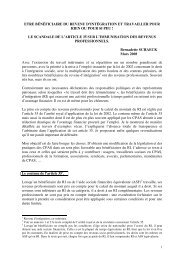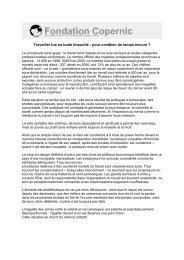Awra Amba RJ 300612 EN - Contacter un comité local d'Attac
Awra Amba RJ 300612 EN - Contacter un comité local d'Attac
Awra Amba RJ 300612 EN - Contacter un comité local d'Attac
You also want an ePaper? Increase the reach of your titles
YUMPU automatically turns print PDFs into web optimized ePapers that Google loves.
21 / 85<br />
2. Backgro<strong>un</strong>d history and geographical situation<br />
disabled people (Me09/33). In 1965/66, he went to a village called Michael Debire (Libo Kemkem<br />
woreda) and lived in a place called Dem<strong>un</strong>a Chalema (Wudo kebele).<br />
In 1966, he met in Sinko (Fogera woreda, Alem Ber kebele), nearly ten kilometres east of <strong>Awra</strong><br />
<strong>Amba</strong>, a group of people who were followers of the so-called Alahim (or Alhaim acc. to Ya08/6)<br />
Muslim sect and lived here. The leader of this sect was Sheik Seid Hassen according to At05/30,<br />
who interviewed three sons of the leader in Amed Ber (officially called Alem Ber according to<br />
Yi07/71). The sect is distinguished from other Muslim traditions for its liberalism and does not<br />
practice the main institutions of Islam such as fasting and prayer. It defends ideals such as honesty,<br />
brotherhood, equality of rights between men and women. Yassin (2008/6) even presents Sheik Seid<br />
Hassen as the grandfather of <strong>Awra</strong> <strong>Amba</strong>. The Alahim sect should represent today aro<strong>un</strong>d 200<br />
people in Alem Ber and in surro<strong>un</strong>ding villages of <strong>Awra</strong> <strong>Amba</strong> (At05/30).<br />
Zumra met often members of the sect. In 1972, he moved with his family from Yesho-Michael (Este<br />
woreda) to Wudo (Demm<strong>un</strong>a Chalema kebele), near to Sinko, then finally to Sinko, where Seid was<br />
living (At05/30).<br />
It should be noted, however, that according to Me09/33, although the visible role the Muslim faith of<br />
his ascendants and contemporaries played in the first years of his ideal, Zumra vehemently denies<br />
that, because he considers the social reality had opened his eyes and not any ideology or religion.<br />
Zumra blames incidentally Atnafu for having produced a defamatory study in 2005, especially about<br />
religion (Yi07/43; Crespo, 2012) (Question 3 in Annex).<br />
In parallel, the fo<strong>un</strong>ders of <strong>Awra</strong> <strong>Amba</strong> were without doubt influenced by the new socialist ideas<br />
introduced in Ethiopia in the late 1960's and the early 1970's, especially through the cooperative<br />
movement (At05/98).<br />
In our opinion, to consider that his thought was inspired at the same time by the f<strong>un</strong>damental values<br />
of religions – he claims today, by Alahim ideals and by the observation of the behaviours of his<br />
fellow citizens does not lessen the visionary nature of Zumra.<br />
His long quest for a village capable of welcoming his ideas was finally satisfied in <strong>Awra</strong> <strong>Amba</strong>,<br />
where he lives today. He fo<strong>un</strong>d here a group of people in agreement with him and ready to give him<br />
permanently a home for creating heaven on Earth. After ten years of occasional visits to the area and<br />
several short stays with them, he decided to settle here in 1972 (Ya08/61; Me09/34; Jo10b/2)<br />
(Question 4 and Question 5 in Annex). The comm<strong>un</strong>ity had at this time 66 households according to<br />
Ya08/61 & 67 or Me09/5 & 34, but only 66 people according to Jo10b/2 (Question 6 in Annex) with<br />
60 ha (Ya08/61) or about fifty hectares (Jo10b/2) of land. Yirga (2007/47) writes on the contrary, by<br />
quoting Zumra, the comm<strong>un</strong>ity was then only a comm<strong>un</strong>ities of values meeting persons living in<br />
different places (Question 7 in Annex). Crespo (2011) reports also, by quoting Zumra, people aro<strong>un</strong>d<br />
him wanted to kill him because they thought he was in contradiction with religion and tradition.<br />
At the beginning, the comm<strong>un</strong>ity was very small and therefore very tight-knit. Zumra explains the<br />
agricultural produce was stored in a common store, the cooking was done in a common kitchen, and<br />
meals were eaten in a common plate (At05/74).<br />
In 1984 Seid and his followers tried to federate into a religious association. But their neighbours,<br />
Muslim or Christian peasants, considered them as deviants or atheists. They deno<strong>un</strong>ced to Derg, the<br />
government of that time, the members of the sect as supporters of the Ethiopian people revolutionary<br />
party (EPRP), which was anti-Derg party at that time. Hence the Derg interrupted the creation of this<br />
association. Seid died in 1985 at the Gondar prison (At05/74).<br />
Zumra tried to bring together his followers into an egalitarian comm<strong>un</strong>ity, i.e. a cooperative (socalled<br />
'<strong>un</strong>ion' by references) (At05/30; Yi07/47), but the people of the neighbouring villages,<br />
outraged by the fact that the men, women and children of <strong>Awra</strong> <strong>Amba</strong> had the same rights, and by<br />
the absence of religion in the comm<strong>un</strong>ity, deno<strong>un</strong>ced it as opposed to the power. Then the Derg<br />
stopped this project and required they fo<strong>un</strong>d a primary-level multi-purpose farmers' cooperative that

















